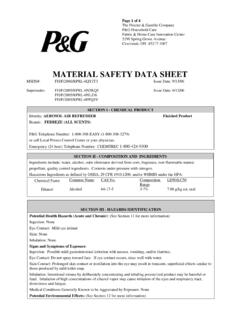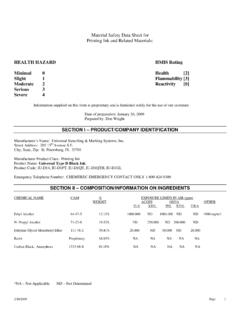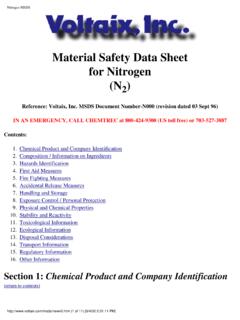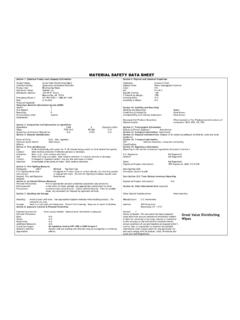Transcription of Acetone Material Safety Data Sheet (MSDS) - NWIC Blogs
1 Acetone MSDS Page 1 of 1 Rev. 01/25/06 Box 864 135 Redstone Street Southington, CT 06489 Toll Free: (800)-4-midsun ( only) (860) 378-0100 (860) 378-0103 (Fax) Acetone Material Safety data Sheet (MSDS) MANUFACTURER S CONTACT INFORMATION: Sunoco, Inc. (R&M) EMERGENCY 1735 Market Street LL Sunoco: (800) 964-8861 Philadelphia, Pennsylvania 19103-7583 Chemtrec: (800) 424-9300 Product Safety : (610) 859-1120 I. Product Identification Trade Name Acetone Product Use Chemical Intermediate II. Hazardous Ingredients of Material Components Amount (Vol. %) CAS No. ACGIH TLV Acetone 100 67-64-1 Exposure Limits (See Section VI for additional Exposure Limits) Governing Body CAS No. Exposure Limits ACGIH 67-64-1 STEL 750 ppm ACGIH 67-64-1 TWA 500 ppm OSHA 67-64-1 TWA 1,000 ppm Emergency Overview: Danger! Extremely flammable liquid and vapor.
2 Vapors may cause flash fire or explosion. Harmful if inhaled. Vapor concentrations may cause drowsiness. Causes skin and eye irritation. Harmful if swallowed. May cause target organ or system damage to the following: Eye, skin, respiratory system, central nervous system. HAZARD RATINGS Key: 0 = Least 1 = Slight 2 = Moderate 3 = High 4 = Extreme Health Fire Reactivity PPI NFPA 1 3 0 HMIS 1 3 0 X III. Physical/Chemical data Appearance & Odor Colorless liquid Boiling Point 133 F Melting Point F Specific Gravity Molecular Weight g/mole pH 7 Odor Sweet, pungent Odor Threshold 62 ppm Vapor Pressure (mm Hg @20 C) 181 Solubility in Water Complete Volatile (wt %) 100% Acetone MSDS Page 2 of 2 Rev. 01/25/06 Acetone Material Safety data Sheet (MSDS) IV. Fire and Explosion data Flash Point Flammable Limits in Air (% By Volume) Lower Upper Auto Ignition Temperature 869 F Unusual Fire & Explosion Hazards Use water spray.
3 Use water spray to cool fire exposed tanks and containers. Acetone /water solutions that contain more than Acetone have flash points. When the Acetone concentration is greater than 8% (by weight) in a closed container, it would be within flammable range and cause fire or explosion if a source of ignition were introduced. Fire Extinguishing Media Water spray, alcohol resistant foam, dry chemical or carbon dioxide. V. Reactivity data Stability Stable Conditions to Avoid Avoid heat, sparks and open flame. Incompatibility Acetone may form explosive mixtures with chromic anhydride, chromyl alcohol, hexacholromelamine, hydrogen peroxide, permonosulfuric acid, potassium terbutoxide and thioglycol. Strong oxidizers. Hazardous Decomposition May produce carbon dioxide, carbon monoxide and other asphyxiants. Hazardous Polymerization Will not occur. VI.
4 Health Hazard and Toxicological data Pre-existing Medical Conditions: The following diseases or disorders may be aggravated by exposure to this product. Skin, eye, lung (asthma-like conditions). Chronic Exposure Effects of Exposure Eyes Contact with the eye may cause moderate to severe irritation. Skin Moderately irritating to the skin. Prolonged or repeated contact can result in defatting and drying of the skin which may result in skin irritation and dermatitis (rash). LD50 mg/kg Rabbit, 20,000 Draize Skin Score: no data Out of Inhalation High concentrations may lead to central nervous system effects (drowsiness, dizziness, nausea, headache, paralysis and loss of consciousness and even death).High vapor concentrations are irritating to the eyes, nose, throat and lungs. LC50 (mg/1) no data LC50 (mg/m3) Rat 8 hrs. 50,000 LC50 (ppm) no data Ingestion Product may be harmful or fatal if swallowed.
5 Pulmonary aspiration hazard. After ingestion, may enter lungs and produce damage. May produce central nervous system effects, which may include dizziness, loss of balance and coordination, unconsciousness, coma and even death. LD50 (g/kg) Rat Acetone MSDS Page 3 of 3 Rev. 01/25/06 Acetone Material Safety data Sheet (MSDS) VII. First Aid Procedures Inhalation Remove to fresh air. If not breathing, give artificial respiration. If breathing is difficult, give oxygen and continue to monitor. Get immediate medical attention. Eye Contact Flush eye(s) with water for 15 minutes. Get medical attention. Skin Contact Immediately flush skin with plenty of water. Remove clothing. Get medical attention immediately. Wash clothes separately before reuse. Ingestion If swallowed, DO NOT INDUCE VOMITING. Give victim a glass of water or milk. Call a physician or poison control center immediately.
6 Never give anything by mouth to an unconscious person. Get medical attention immediately. See Section X for additional first aid information. VIII. Preventive Measures Consult with a Health and Safety Professional for Specific Selections A. PERSONAL PROTECTIVE EQUIPMENT Respiratory Protection Concentrations in air determines the level of respiratory protection needed. Use only NIOSH certified respiratory equipment. Half-mask air purifying respirator with organic vapor cartridges is acceptable for exposure to ten (10) times the exposure limit. Full-face air purifying respirator with organic vapor cartridges is acceptable for exposures to fifty (50) times the exposure limit. Exposure should not exceed the cartridge limit of 1000 ppm. Protection by air purifying respirators is limited. Use a positive pressure-demand full-face supplied air respirator or SCBA for exposures greater than fifty (50) times the exposure limit.
7 If exposure is above the IDLH (Immediately Dangerous to Life and Health) or there is a possibility of an uncontrolled release, or exposure levels are unknown, then use a positive pressure-demand full-face air respirator with escape bottle or SCBA. Wear a NIOSH-approved (or equivalent) full-face piece airline respirator in the positive pressure mode with emergency escape provisions. Eye/Face Protection Splash proof chemical goggles or full-face shield recommended to protect against splash of product. Clothing/Gloves The glove(s) list below may provide protection against permeation. Gloves or other chemically resistant materials may not provide adequate protection. Protective gloves are recommended to protect against contact with product. Neoprene, Natural rubber. Engineering Controls Use with adequate ventilation. Ventilation is normally required when handling or using this product to keep exposure to airborne contaminants below the exposure limit.
8 Use explosion-proof ventilation equipment. Other The following materials are acceptable for use as protective clothing; Neoprene, Natural rubber. Facilities storing or utilizing this Material should be equipped with an eyewash facility and a Safety shower. Remove contaminated clothing and wash before reuse. B. STORAGE AND HANDLING Storage Conditions Keep away from heat, sparks and flame. Store in a cool, dry place. Keep container closed when not in use. Handling Procedure Use only in a well-ventilated area. Ground and bond containers when transferring Material . Avoid breathing (dust, vapor, mist, gas). Avoid contact with this Material . Wash thoroughly after handling. Do not use air pressure to unload containers. Continued on Next Page Acetone MSDS Page 4 of 4 Rev. 01/25/06 Acetone Material Safety data Sheet (MSDS) VIII. Preventive Measures (Continued) C.
9 ENVIRONMENTAL PROTECTION Spill and Leak Procedure Prevent ignition, stop leak and ventilate the area. Contain spilled liquid with sand or earth. DO NOT use combustible materials such as sawdust. Use appropriate personal protective equipment as stated in Section VIII of this MSDS. Advise the Environmental Protection Agency (EPA) and appropriate state agencies, if required. regulations require reporting spills of this Material could that reach any surface waters. The toll-free number for the Coast Guard National Response Center is (800) 424-8802. After removal, flush contaminated area thoroughly with water. Waste Disposal Follow federal, state and local regulations. In Canada, follow federal, provincial and local regulations. This Material is a RCRA hazardous waste. DO NOT flush Material to drain or storm sewer. Contract to authorized disposal service.
10 Ecological Information This product is not expected to persist in the environment. D. TRANSPORTATION INFORMATION Governing Body DOT Proper Shipping Name Acetone Mode Ground Hazard Class 3 (Flammable Liquid) UN/NA Number UN1090 IX. Regulatory Information/Classifications Regulatory List Component CAS Number ACGIH Occupational Exposure Limits Carcinogens Acetone 67-64-1 ACGIH Occupational Exposure Limits TWAs Acetone 67-64-1 ACGIH Short Term Exposure Limits Acetone 67-64-1 CAA (Clean Air Act) HON Rule SOCMI Chemicals Acetone 67-64-1 Canada WHMIS Ingredient Disclosure Acetone 67-64-1 CERCLA/SARA Hazardous Substances and their RQs Acetone 67-64-1 CERCLA/SARA Hazardous Substances and their RQs Acetone 67-64-1 CERCLA/SARA Hazardous Substances and their RQs Acetone 67-64-1 inventory Australia (AICS) Acetone 67-64-1 inventory Canada Domestic Substances List Acetone 67-64-1 inventory China Acetone 67-64-1 inventory European EINECS inventory Acetone 67-64-1 inventory Japan (ENCS)







